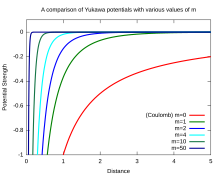Yukawa potential
The Yukawa potential (after the Japanese physicist Hideki Yukawa ; also called shielded Coulomb potential ) is the potential
of exchange particles of the mass , as they occur in the residual interaction of the strong interaction and in superconductors (see below). Yukawa showed in 1935 that such a potential is caused by the interaction of matter with scalar and pseudoscalar bosons ( Yukawa interaction ). He thus postulated the existence of an exchange particle in the atomic nucleus that was later identified as the pion ( pion exchange model ).
Here is
- the dimensionless coupling constant of the respective interaction,
- the reduced Planck quantum of action ,
- the speed of light ,
- the mass of the exchange particle and
- the distance between the particles.
The Yukawa potential tends exponentially towards zero with increasing distance . The range of the associated force depends on the magnitude of the reduced Compton wavelength of the exchange particles.
Coulomb potential and photon mass
In the borderline case , the Yukawa potential changes into the Coulomb potential , as it is generated by massless photons , the exchange particles of the electromagnetic interaction . If the photon had a mass, the electrostatic potential would not be a Coulomb potential, but a Yukawa potential. In all previous measurements in a vacuum, however, the photon mass has proven to be below the detection limit .
In superconductors , on the other hand, there is spontaneous symmetry breaking . At the transition between vacuum and superconductor, the calibration symmetry of the electromagnetic potentials is broken, because in the superconductor one phase is marked in the macroscopic wave function of the Cooper pairs . This can be interpreted as if the photon in the superconductor had a mass. Correspondingly, magnetic fields in superconductors, as observed with the Meissner-Ochsenfeld effect , decay exponentially.
Individual evidence
- ^ Hideki Yukawa: On the Interaction of Elementary Particles. I . In: Proceedings of the Physico-Mathematical Society of Japan. 3rd series . tape 17 , 1935, pp. 48–57 ( jst.go.jp [PDF; accessed March 7, 2017]).
- ^ Hideki Yukawa, Shoichi Sakata: On the Interaction of Elementary Particles II . In: Proceedings of the Physico-Mathematical Society of Japan. 3rd series . tape 19 , 1937, pp. 1084-1093 ( jst.go.jp [PDF; accessed March 7, 2017]).
- ^ Hideki Yukawa, Shoichi Sakata, Mitsuo Taketani: On the Interaction of Elementary Particles. III . In: Proceedings of the Physico-Mathematical Society of Japan. 3rd series . tape 20 , 1938, pp. 319–340 ( jst.go.jp [PDF; accessed March 7, 2017]).











